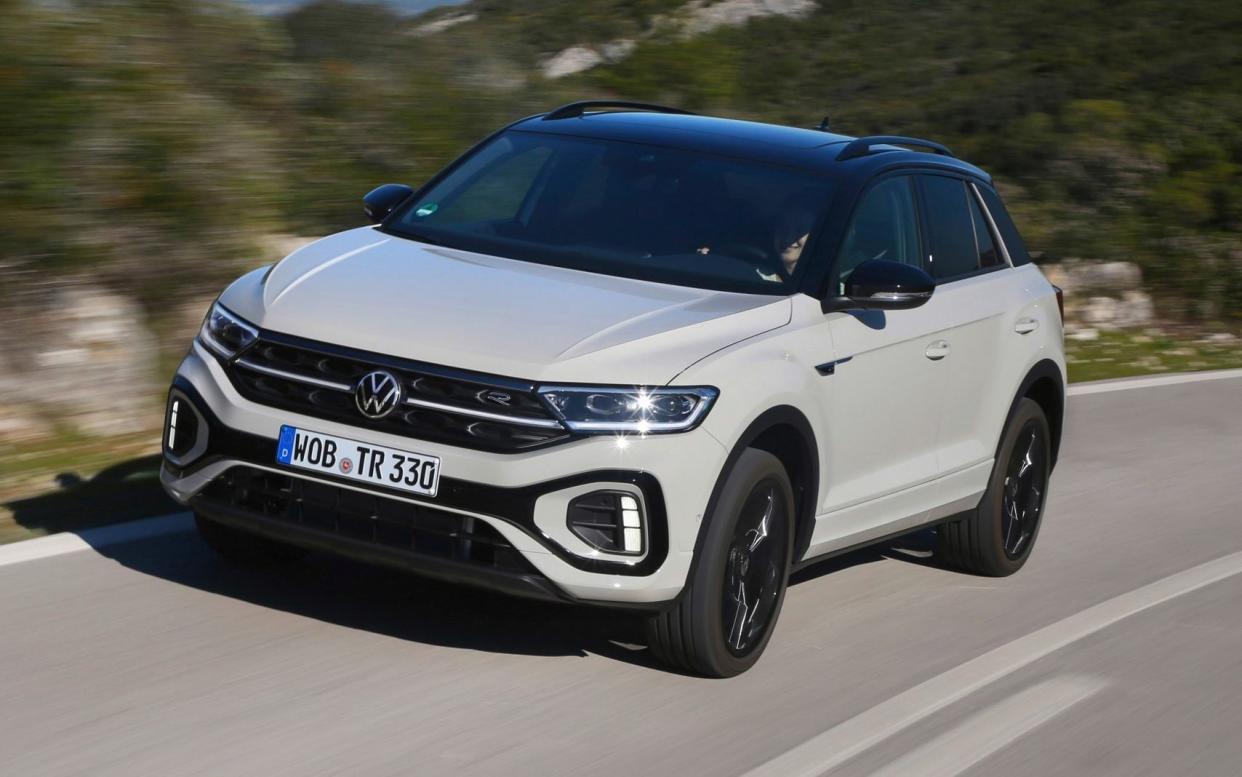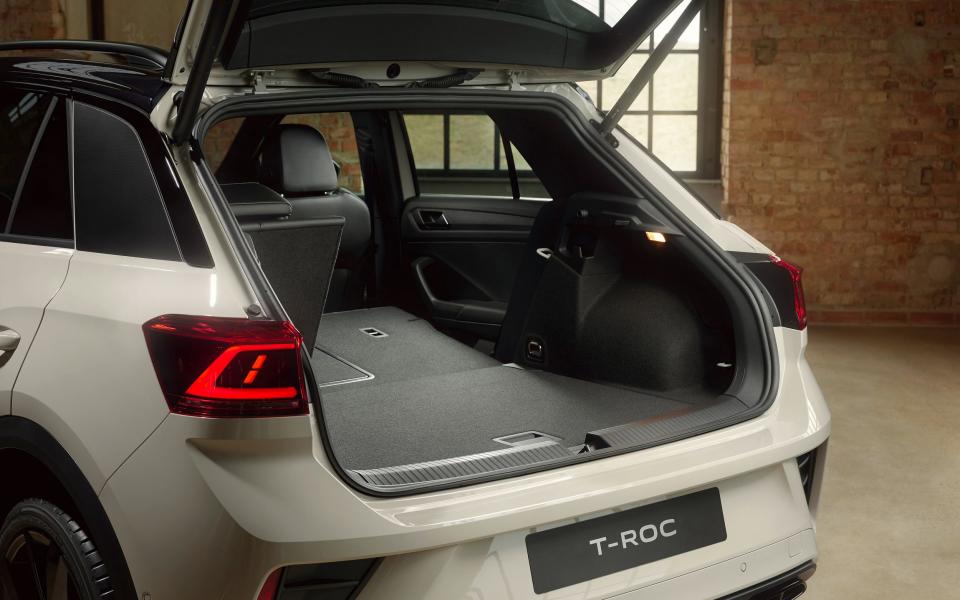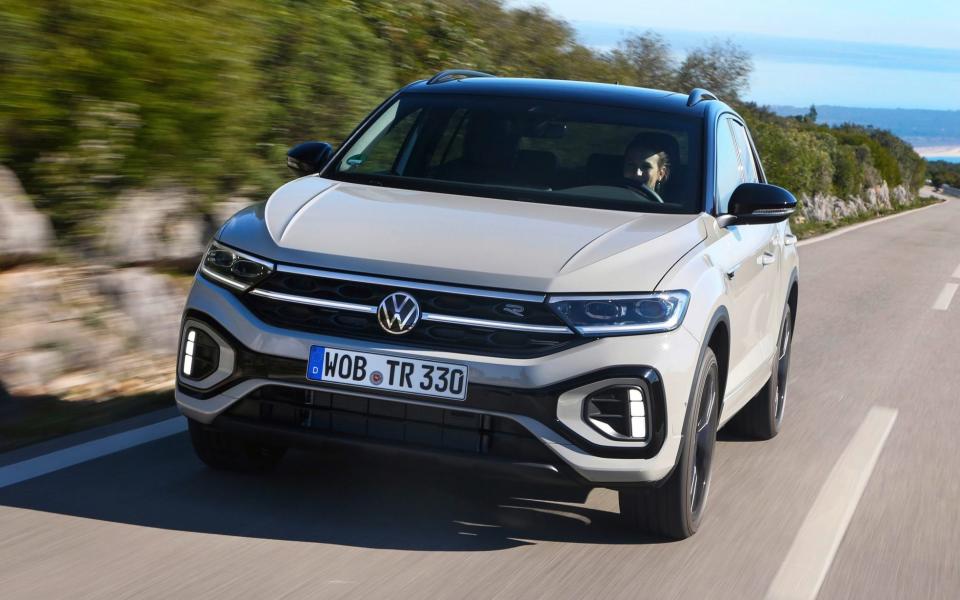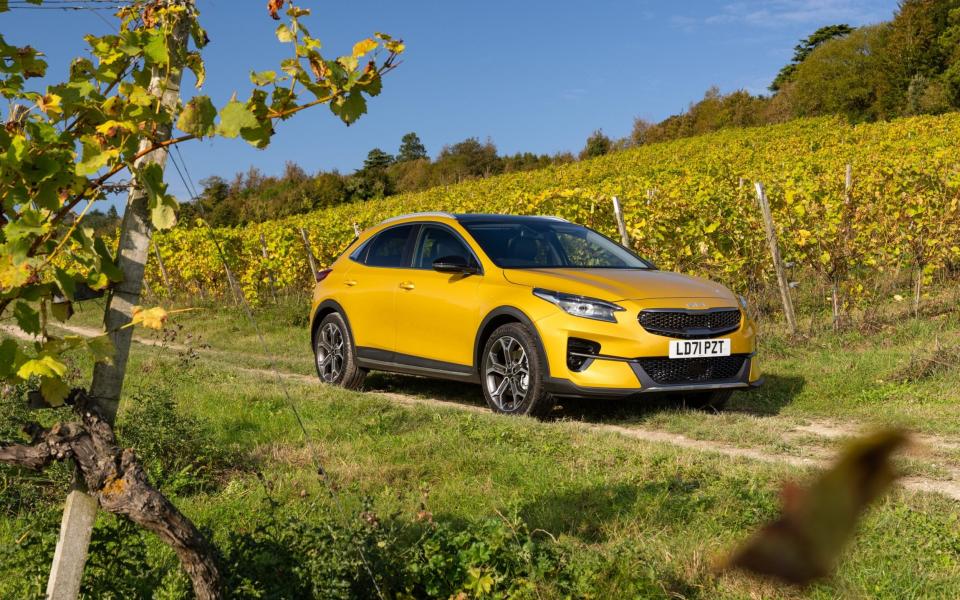Volkswagen T-Roc review: beneath the nip and tuck, VW’s lifted Golf is still middle-of-the-road

Some car reviews write themselves. You sit down at the computer, and try out a few intros, and before you know it, one of them feels right, and away you go.
Sometimes, though, you sit down and try to find a witty and engaging way to start talking about the car in front of you, and… well, it’s a bit like trying to find a witty and engaging way to talk about a magnolia wall.
Anyway, this is the new Volkswagen T-Roc. It’s what would happen if you took apart a Golf and tried to make a Nissan Qashqai out of the bits. Given that that’s exactly what a big chunk of British buyers are looking for these days, it’s no wonder it’s become one of Volkswagen’s most popular models.
It’s just had a facelift, too, and in the hope of adding some much-needed sparkle, Volkswagen has tinkered with the looks and given the interior a comprehensive update. So let’s find out whether that’s done the trick.
Pros
Reasonably spacious
Powerful engine
Generous equipment
Cons
Fidgety ride
Uninvolving drive
Not hugely versatile
The more things change…
The VW T-Roc still gets the same line-up of engines with this 2022 update, and that’s no bad thing given that most of VW’s current engines are pretty decent. Our pick would probably be the eager little 1.0-litre 108bhp petrol with the six-speed manual, but our test car has the 1.5-litre 148bhp unit. Also available are a 187bhp 2.0-litre petrol that comes as standard with four-wheel drive, or a choice of two 2.0-litre diesels of 113bhp and 148bhp respectively, the latter available with an automatic gearbox and optional four-wheel drive.

Excluding the range-topping R, with its blistering 296bhp 2.0-litre turbo, there are three trims in the T-Roc range: Life is your entry-level offering but is still generously equipped with 16-inch alloy wheels, adaptive cruise control, two-zone climate control, ambient lighting and LED headlights.
Upgrade to the Style version we’ve got here to get 17-inch wheels, satellite navigation, and digital gauges, or go one step further to the R-Line if you want heated front seats and sportier looks.
The car we’re testing here will set you back a fiver short of £30,000, which is more expensive than the Nissan Qashqai and the T-Roc’s other most obvious rival, the Kia XCeed, but less than a hybrid Toyota C-HR.
Penny pinching
Having said that, the T-Roc claws back its up-front costs by being affordable to run, with better fuel economy than either the Kia or the Nissan. It’s predicted to hold on to more of its value, too, so in the long run it’ll actually be cheaper per mile than all but the C-HR; besides, if you go for the C-HR, you have to live with the more lethargic and rather noisy 1.8-litre hybrid engine.
The big news with the T-Roc’s facelift is the new interior, of course, and this was all but necessary given the rather half-hearted effort the T-Roc had before. With cheap, scratchy plastics it was the car’s worst facet, but that’s all changed thanks to some much higher quality fittings and a redesigned layout.

Granted, the faux stitching across the top of the dash is rather gauche and, of course, completely pointless, but the rest of it looks and feels generic yet decent enough.
Thankfully, this being an older VW beneath the skin, it hasn’t suffered from the addition of Volkswagen’s latest infotainment system, so the software is the more responsive older system, and you get a separate climate control panel.
Having said that, the temperature panel itself is touch-sensitive, which makes it harder to operate on the move than it needs to be and, of course, the gloss black surface ends up covered in greasy fingerprints.
Room to manoeuvre
Given that the T-Roc is effectively little more than a hatchback with raised ground clearance, it’s surprisingly roomy with plenty of space in both rear and front seats.
But, while the 445-litre boot is bigger than that of a Golf, it’s also smaller than the Qashqai’s. The T-Roc is also much less versatile than the Skoda Karoq, with which it shares a platform, and which gets individual rear seats that slide, fold, tumble and can even be removed.

By contrast, the T-Roc’s seats are fixed, and their backrests fold down in the usual 60/40 split. The boot floor is variable in height, though, which means you can set it low to maximise space, or raise it up to create a flush load bay along which you can slide longer items when the rear seats are folded.
This sense of averageness continues once you get the T-Roc out on the road. The 1.5-litre engine is gutsy enough, if rather coarse when worked hard. The six-speed manual gearbox’s ratios are well chosen, but the gear lever’s action is a little notchy. And while throttle response is crisp, it’s rather bereft of feel – as is the clutch – so getting smooth and accurate gear-changes and pull-aways is a bit of an art form.
Something and nothing
You get plenty of grip and neutral handling, but there’s also a light, rather disconnected feel to the steering which, compounded by soft body control, means you’re never inspired to drive the T-Roc hard either.
Of course, very few of its owners will do so anyway, so you could argue this isn’t really an issue. But there are SUVs out there that will do practicality and versatility while also offering up a bit of deftness in the chassis department – notably, the Karoq and Seat Ateca, another T-Roc platform-mate, both of which are endowed with an agility the T-Roc lacks.
You’d hope this softness would engender a certain amount of comfort in the T-Roc, but while there is some give in the suspension there’s also a lumpy, jostling nature to the T-Roc’s ride at low speeds that means on urban roads it never really feels settled.

And if the tarmac gets scruffier, the T-Roc certainly lets you know about it. Not just through the seat of your pants, but also through your ears, because you can’t just feel the suspension working away – you can hear it too, which makes the ride quality’s deficiencies feel all the more apparent.
Chances are that all of these issues would be significantly improved if you opt for the Life version, with its 16-inch wheels and plumper tyres. So if you are dead-set on a T-Roc, that’s where I’d spend my money, if I were you.
Out on the motorway the ride comfort is better, though you still notice expansion joints and scarred sections of road surface more than you’d like. The engine is relatively well muted, though wind and tyre noise are both average (there’s that word again).
The Telegraph verdict
The thing is, average really does describe the T-Roc rather well. It isn’t the smoothest-riding car out there, but neither is it so uncomfortable as to be a deal breaker. It doesn’t handle brilliantly, but it’s competent enough to make you feel secure.
Inside, there’s enough quality to keep you happy if you don’t look too hard, but not so much that you really feel cosseted and pampered. And while it’s spacious enough for a family of four, its lack of clever seating means it lags behind some rivals on versatility.
On the plus side, the T-Roc should be relatively affordable to own. It’s also generously equipped, which means it might just count as decent value. It’s just a bit of a shame that it’s about as exciting to spend time with as… well, a magnolia wall.
The facts
On test: Volkswagen T-Roc 1.5 TSI 150 Style
Body style: Five-door SUV
On sale: Now
How much? £29,995 on the road (range from £28,520)
How fast? 129mph, 0-62mph in 8.4sec
How economical? 47.1mpg (WLTP Combined)
Engine & gearbox: 1,498cc four-cylinder petrol engine, six-speed manual gearbox, front-wheel drive
Electric powertrain: n/a
Electric range: n/a
Maximum power/torque: 148bhp/184lb ft
CO2 emissions: 135g/km (WLTP Combined)
VED: £230 first year, then £165
Warranty: 3 years / 60,000 miles (unlimited in first two years)
Spare wheel as standard: No (optional extra)
The rivals
Nissan Qashqai 1.3 DIG-T MHEV Acenta Premium

138bhp, 44.7mpg, £28,645 on the road
You pay less for this Qashqai but you also get less – less power, and fewer toys. And despite the fact that this variant is less powerful than the T-Roc, and the fact that it comes with a mild hybrid engine, it’s actually less fuel efficient. Work that one out. The latest Qashqai isn’t bad, and it’s more interesting to drive than the T-Roc – but it is underwhelming in several areas.
Skoda Karoq 1.5 TSI 150 SE L

148bhp, 43.8mpg, £28,695 on the road
The Karoq is our favourite car of this type, with slick handling, a comfortable ride, and that brilliantly versatile rear bench that folds, slides and flips this way and that. Granted, it isn’t quite as fuel efficient as the lower, sleeker VW, and neither will it hold its value quite as well, but the Karoq is worth the extra cost.
Kia XCeed 1.5 Turbo GT Line S

158bhp, 44.8mpg, £29,995 on the road
It’ll cost you the same as the T-Roc, but this top-spec XCeed gets lashings more equipment, a seven-year warranty, sportier looks and even 10bhp more. Of course, its big wheels and stiff suspension will make it even lumpier on rough roads than the T-Roc, while the cramped back seats and small boot mean it isn’t as good a family hauler. Perhaps, then, the XCeed is better on paper than in the flesh.
For new and used buying guides, tips and expert advice, visit our Car Advice section, or sign up to the Telegraph Cars newsletter here and to join the Telegraph Motoring Club Facebook group click here

 Yahoo Movies
Yahoo Movies 
